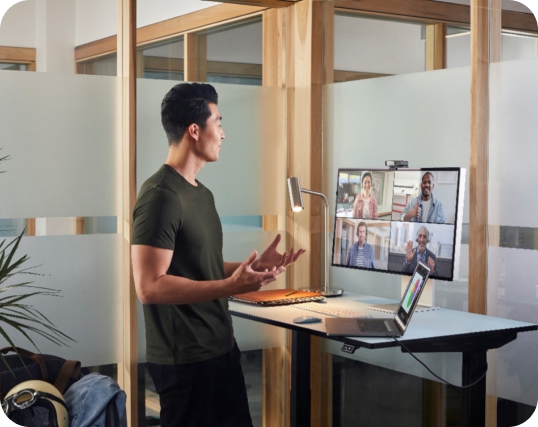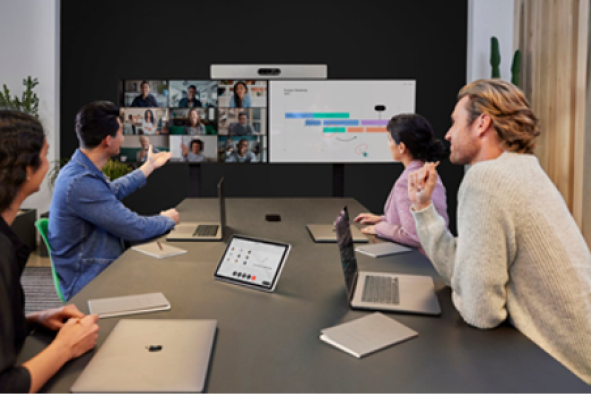
Learn More
What is hybrid work?
Definition: Hybrid work is a flexible work model that supports a blend of in-office, remote, and on-the-go workers. It offers employees the autonomy to choose to work wherever and however they are most productive.

What is a hybrid work model?
Hybrid work is a people-first approach to managing the workforce that drives increased productivity and job satisfaction while addressing the major challenges of remote work, such as isolation and lack of community. A hybrid work model provides employees with greater flexibility and the option to work from home or anywhere they can be productive. With hybrid work, the workplace is no longer inside the four walls of the corporate office—it’s an ecosystem of employees working from home, in coworking spaces, and the office. Team members can migrate between various locations depending on the work they need to get done.
The hybrid work model can take different forms depending on the organization and the type of work being done.
What are the types of hybrid work models?
These are the four most common hybrid work models:
1. Flexible hybrid work model
Employees choose their location and working hours based on their priorities for the day. For example, if they need to spend time focusing on a project, they can choose to work from home or in a coffee shop. If they want a sense of community, need to meet with their team, attend a training session or join a town hall, they can choose to go into the office. Cisco is leveraging this model and offering its employees the option to choose where they work on any given day.
Benefits:
- Offers freedom and flexibility for individuals to determine where and when they work
- Builds a trust-based relationship with employees, which increases loyalty and job satisfaction
- Expands talent pool, leading to more diverse thinking
- Improves the bottom-line due to cost savings on office space and travel
Challenges:
- Difficult for employees to find a suitable day or time for in-person teamwork
- Lack of visibility into how many people are going to the office on any given day and if the building has the capacity to support them
2. Fixed hybrid work model
The organization sets the days and times employees are allowed to work remotely or go into the office. For example, it could be that certain teams go into the office on Mondays and Wednesdays, while others go in on Tuesdays and Thursdays. Or an organization could allow everyone to work from home on pre-determined days each week. American Express is an example of an organization that has adopted a fixed hybrid work model.
Benefits:
- Increases opportunity for in-person collaboration and team building
- Gives employees the option to schedule appointments or run quick errands on certain days of the week
- Provides the ability to easily forecast office capacity
Challenges:
- Lack of individual choice, which could lead to a loss of productivity if employees aren’t in the optimal setting for the work that needs to be done
- Inability to reduce office space
3. Office-first hybrid work model
Employees are expected to be on-site but have the flexibility to choose a few days a week to work remotely. Google plans to adopt this type of model where employees work in the office three days a week but have the option to choose two days for working remotely.
Benefits:
- Allows flexibility and individual choice
- Helps maintain company culture and community
Challenges:
- Lack of visibility for employees around who will be in the office and when
- Inability to accurately forecast how many employees will be in the office on a given day
4. Remote-first hybrid work model
Employees work remotely most of the time with occasional visits to coworking spaces or the office for team building, collaboration, and training. In this model, the company may not have an office space and instead relies on team members in the same area to get together when they see fit. Twitter adopted this remote-first model and will allow all employees to work from home.
Benefits:
- Increases productivity and job satisfaction for employees who want to work remotely most of the time
- Provides the ability to reduce costs by reducing or eliminating office space
Challenges:
- Potential for employees to feel isolated
- Increased challenges maintaining the company culture and community
What factors are driving hybrid work?
Hybrid work emerged as a viable work arrangement during the COVID-19 pandemic when businesses transitioned to remote work and used virtual collaboration tools to remain productive. While some organizations had hybrid and remote workers before the pandemic, those working arrangements accelerated overnight as most of the workforce went from in-person meetings to kitchen table virtual collaboration.
Now, after realizing the benefits and challenges of remote work, organizations are adopting hybrid work models to extend greater flexibility to employees while maintaining the in-person interactions that are crucial for the company community and culture.
Numerous surveys and research reveal the factors driving hybrid work:
- Remote work has largely proven successful: A majority of executives have seen notable improvements in individual productivity, and diversity and inclusion, according to McKinsey.
- Employees are demanding greater flexibility: 57% would consider leaving their company if they had to return to the office full-time, according to Dimensional Research.
- Businesses see an opportunity to reduce travel and real estate costs: 74% of CEOs from large organizations expect to reduce their office space, according to Fortune.
- Sustainability is top of mind: Daily global CO2 emissions decreased by 19% during the COVID-19 pandemic, nearly half of which resulted from reduced ground transportation, according to research by Nature. Reduced commutes and business travel from hybrid work coupled with a reduction in office space heating and electricity will help promote a more sustainable future. These changes can assist the 60% of Fortune 500 companies with sustainability targets achieve their goals.
What are the benefits of hybrid work?

The shift to hybrid work brings considerable benefits to both employees, businesses, and the environment. It promises to deliver increased flexibility, productivity, and job satisfaction for employees. For the business, it improves the bottom line and expands the talent pool. And the reduction in travel and office spaces leads to a more sustainable future.
Recent research conducted by Dimensional Research reveals:
- 99% of knowledge workers see the benefits of working from home, including increased flexibility, no commute, and having more time to spend with friends and family
- 95% of knowledge workers want to return to the office for activities such as team building, collaboration, and connection to peers
- 53% of large organizations plan to reduce their office footprint, which reduces costs
What is a hybrid work schedule?
A hybrid work schedule is based on flexibility. Your hybrid work schedule will depend on the type of hybrid work model your organization chooses to implement. For some organizations, it will be up to the employee to decide when and where they work on any given day. Others will have set schedules to ensure that teams in the same location can meet in the office or a coworking space for collaboration and team building.
While hybrid work gives you the flexibility to choose your schedule, it’s important to communicate your working hours with your team. Team leaders should approach each individual situation with empathy and understanding, and work with their team members to identify a schedule that works for everyone.
A key pillar of hybrid work is the shift from focusing on location and hours worked to the outcomes that are delivered.
How do I build a hybrid work culture?
Organizations may have concerns about maintaining culture and community when they extend greater flexibility to the workforce. Without watercooler chats or opportunities to interact with colleagues outside of your job function, it can be difficult to facilitate the cross-pollination of ideas. And if the company culture and a sense of shared purpose diminish, it can lead to a loss of productivity and higher turnover.
Therefore, building a culture based on inclusivity, empathy, and trust will be one of the most important aspects of hybrid work.
As work has expanded beyond the walls of the office, keeping the culture intact requires a shift in the way we think about shared purpose. Colleagues need to work together and build connections, whether they are in a room together or virtual, and your collaboration solution needs to facilitate interactions that would occur if people were together in-person.
Organizations can have the best of both worlds when they bring the office and virtual worlds together. Employees can choose where they want to work without missing out on the personal connections and team building that are beneficial to company culture.
Are hybrid and remote work good or bad for employee engagement?
They are a good thing! While many expect employee engagement to drop if employees aren’t going into the workplace every day, research shows that hybrid and remote work can improve employee engagement. In a recent survey, 79% of knowledge workers indicated that their engagement level has stayed the same or improved since they began working remotely.
Is it safe to return to the office?
For information on when it is safe to return to the office, visit your local government COVID-19 planning site. If you’re in the U.S., visit the CDC for the latest guidance.
Bringing people back into the office likely means new protocols and policies to keep employees safe. Social distancing, proof of vaccination, mask requirements, and limiting how many people are in the building may be enforced to ensure safety.
97% of the workforce have concerns about returning, including touching shared office devices, knowing when a room was last cleaned, and knowing if a room is over capacity for safe social distancing. While policies and technology can assist in making the environment safer, the concerns of the workforce will need to be addressed. Communicating these changes will be key to making employees feel comfortable.
For more information on how technology can assist in providing a safe return to the office, download the How-to Collaboration Guide for the Hybrid Workplace.
Why should I go into the office?
The office is also a great place to go if you need to remove yourself from a distracting home environment, need to collaborate with your team, or want a sense of community. For many organizations, the office will act as the central hub for rich collaboration experiences, building connections with colleagues, and engaging in education and training.
95% of knowledge workers say they will go into the office for activities such as:
- Team building
- Collaboration
- Connections with peers
With a hybrid work model, the purpose of the office must evolve, as will the capabilities that are offered in each space. With 98% believing their future meetings will contain remote participants, video conferencing technology should be available in most spaces. If you plan to reduce your office footprint, you’ll need hot-desking and office navigation technology to ensure that everyone can stay productive and get started quickly in any space.
Is there a difference between hybrid work and working from home?
Yes, hybrid work and remote work are different. Remote workers work from home all the time and may not have the option to go into the office. While hybrid workers will spend a portion of their time working from home, they also have the flexibility to choose where and when they work. According to research, 49% of remote workers feel isolated, 37% encounter more distractions, and 35% find it hard to connect with their colleagues. Hybrid work provides options for employees to decide which days they want to go into the office. If a person is feeling a sense of isolation, wants to remove themselves from a distracting environment, or connect with colleagues, they have the option to go into the office.
What’s the best collaboration solution for hybrid work?
Choosing the right collaboration solution is one of the most important decisions you’ll need to make as you adopt a hybrid work model. When the pandemic hit, many organizations had to make quick decisions about what technology they were going to adopt to support a remote workforce. But quick decisions are not often the best decisions.
Hybrid work redefines what it means to work and collaborate in a more distributed yet more connected world. This shift challenges us to rethink the experiences employees need to remain productive and easily collaborate wherever they are. T-Mobile is a great example of a company that quickly realized the challenges of hybrid work and invested in a comprehensive hybrid work solution to help bridge the gap between remote and in-office workers.

When evaluating the best solution for hybrid work, you’ll want to look at the experience and needs of every employee in the organization. Start by asking key questions, including:
- Are my employees equipped to work from home?
- Can my employees expect the same collaboration experience whether they are in the office or at home?
- Can the solution provide IT with the ability to easily scale, monitor, and manage the experience when employees are working from home or in the office?
- Do employees feel included in meetings? Are there easy ways for them to engage and be seen and heard?
- Is the collaboration solution secure?
At Webex, we’re continuously innovating to make working from home and in the office an inclusive, secure, and connected experience for everyone. Learn more about how Webex is solving the challenges of hybrid work.
Continue your hybrid work journey

Take the Hybrid Work Readiness Assessment
In 10 minutes or less you can evaluate and benchmark your organization's hybrid work readiness.

Understand the 6 strategies for hybrid work success
365 days. 3 global surveys. 3,935 workers. Our quest to understand the changing nature of work and collaboration all boiled down to 6 transformative strategies. Download the report.

Explore Cisco's Hybrid Work Index
Cisco analyzed millions of records of customer telemetry data – aggregated and anonymized – to uncover insights and trends for the hybrid work era.



